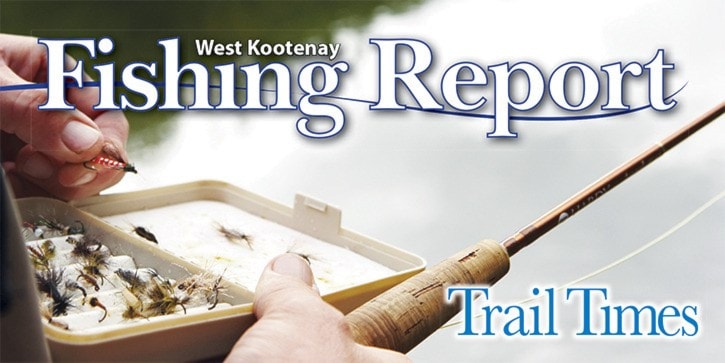The Kootenay Lake supplement for the West Kootenay Fishing Report is submitted by Kerry Reed at Reel Adventures Sport Fishing Charters in Nelson. Contact him at 505-4963 or at reeladventuresfishing.com.
Kootenay Lake:
We spent a lot of time on the lake throughout December and the results were similar to November. It seems like the fish are now on their winter schedule of feeding only a few times a week.
One day we would catch 10 to 15 fish, and then the next day would only manage a few fish. That’s fishing, I guess you just have to be out there.
We’ve been catching Rainbows from two to 12 Lbs lately. Lots of smaller ones, with the odd big one mixed in to keep things exciting.
Our holiday season was as busy as ever. Spending every day on the water with new clients was a blast. Most of the days we were catching the usual mix of two to five pound fish. But it seemed to be about every third day we would hook into a big fish over 10 pounds.
The tourists were excited. Not many places offer comfortable fishing from a boat in the middle of winter. So, even the ski tourists were happy to take a day off and go fishing. Although with the latest snow fall, the skiers might want to take advantage of the hill now. But even after shredding the slopes for a few days, they may need a break. And fishing is a great way to enjoy your break.
And now, as we move into January, I’m hoping to see some of our biggest fish show up. In most years, this is our big fish season. January, February, and March are usually a bit slower fishing, but seem to produce the biggest fish. Although this year has been abnormal, we’re still expecting to see some big brutes. Stay tuned.

What are they biting on?
Most of our fish have been caught on the surface lately. The usual suspects have been working well.
Bucktail flies in my favorite colors of: purples, grays, and blacks have all been working well. Or, if you want to get specific, here’s my favorite numbers lately: 203, 207, 215, 222, 224.
Also, Lyman plugs have been producing fish. My favorites have been “Shizam” #69, “Purple Jesus” #160, and the usual “cop car” # 98 .
We’ve also been catching a few on the downriggers lately. Using the same plugs as above, or the usual flasher-hoochie combo. Favourite depths have been 100-150 feet.
It’s also that time of year when the water temperature is at its coolest. So, remember to slow down. The fish aren’t as aggressive as in the fall.
Remember: there’s no bad days.
The Columbia River is heating up with reports of rainbows between two and four pounds being caught. Roe and worms are popular baits, but shrimp tails are proving excellent trout attractors. Bring some quick tying thread to keep the bait on, as single barbless hooks are mandatory in the Columbia.
Set up: The standard three-way rig with a 10-12-pound main line tied to a three-way swivel with two to three feet of six-to-eight pound leader tied to the opposite end. Thread on the float, and tie a #4-6 Gamagatzu hook, add a marshmallow for more attraction and/or bait. Depending on float preference, anglers use coloured marshmallows, corkies, strike indicators, and spin ‘n glows in a variety of sizes and colours.
Attach a 5/8- to one-ounce weight (depending on rate of current) to an eight- to 30-inch line coming off the dropper swivel. The weight holds on the bottom while the float suspends your bait in the current.
Technique: Identifying where the fish are feeding is the most vital and difficult part of fishing. In winter, most feed near the bottom in which case a shorter dropper line is required, but if trout are surfacing, extend the length of the leader, and/or the weight line to attract trout cruising through the water column.
Cast to seams and back eddies where trout hold in the current waiting for food to be carried into their waiting mouths. Remember trout attack food from below, and are usually holding looking upwards.
Patience is key, and while action may be sparse at times, it can also be fast and furious when the bite is on.
Fly fishing can also be very productive in winter. Full sink lines or sink tips with four-to six-foot leaders retrieved slowly along or near the bottom is the best method. Woolly buggers, streamers, San Juan worms, and stonefly nymphs are some of the more popular winter patterns.
Hard-water action abounds in the West Kootenay. Favourite lakes for ice fishing include Rosebud, Third Champion, Nancy Greene, and Cottonwood Lake.
Bare necessities: You’ll need an ice auger, ice-fishing rod, bait (worms), split shot, #8-12 hook and something warm to drink.
Techniquie: Ice fishing is about as easy as fishing gets. Once you drill your hole, add a split shot to your line, bait your hook, and let it sink to the bottom. When the line goes slack, reel it in so the baited hook is suspended about a foot off the bottom. You can then attach a bobber to the line, or a bell to the rod tip to alert the angler to a strike, or jig the rod occasionally to lend it a livelier effect.
Check B.C. fishing regulations for restrictions.
